| Designation: | M48 |
 |
|---|---|---|
| Manufacturer: | General Dynamics Land Systems - GDLS | |
| Product type: | Armoured Vehicles | |
| Name: | Main battle tank |
In October 1950, Detroit Arsenal Tank Plant began design work on a new tank armed with a 90 mm gun and, in December the same year, the Chrysler Corporation was awarded a letter of intent to design the new tank under the designation T48. Design work began in late December and six prototypes were built, the first being completed in December 1951. In March 1951, before the prototypes had been completed, the Fisher Body Division of the General Motors Corporation and the Ford Motor Company at Livonia were both given a production contract for the tank. Chrysler's first production M48 rolled out of the Delaware Tank Plant and was christened by Mrs George S Patton Junior on 1 July 1952.
The first production M48s were completed in 1952 and production of the M48 series amounted to 11,703 units, about 6,000 of which were built by the Chrysler Corporation at the Delaware Tank Plant which continued production until 1959. Alco Products of Schenectady also built a number of M48A2 tanks.
Many components of the M48 are also used in the M88 ARV as well as the M53 SPG, and further development of the tank resulted in the M60 series, production of which was finally completed at the Detroit Tank Plant in September 1987. Initial production of the M60 MBT was in fact undertaken at the Delaware Tank Plant but in 1959 a decision was taken that all future production would be undertaken at the Detroit Arsenal Tank Plant. The latter facility was run by General Dynamics Land Systems but this has now been closed down.
The cast hull of the M48 is boat-shaped with additional sections welded into position. A hull escape hatch is provided in the floor of the tank. The turret ia a one-piece casting.
The driver is seated at the front of the hull in the centre and is provided with a single-piece hatch cover that opens to the right, forward of which are three M27 periscopes. For driving at night, an M24 infrared periscope is placed in the turntable located in the driver's hatch.
The other three crew members are in the turret with the commander and gunner on the right and the loader on the left. The commander is provided with an M1 cupola which he can traverse by hand through 360°. This cupola is equipped with five vision blocks and an M28C sight for controlling the 12.7 mm (0.50) machine gun. The M28C has a magnification of x 1.5 and a 48° field of view. The coincidence range-finder is operated by the tank commander and has a maximum range of 4,400 m and a magnification of x 10.
The gunner is seated forward and below the commander and has a roof-mounted periscope sight with a x 8 magnification and a telescope with a similar magnification linked to the main armament. The ballistic computer is an electromechanical device which has been designed to compute superelevation angles for the main armament. It receives range information in the form of shaft rotation from the range-finder. The data are then applied to the ammunition data and ballistic corrections which have been entered into the computer by the gunner. The end product is the superelevation angle which is transmitted through the ballistic drive to the periscope. The ballistic drive also transmits the same superelevation angle to the range-finder which is operated by the tank commander. The loader is provided with a single-piece hatch cover that opens to the rear. Mounted to the top rear of the turret is a dome-shaped ventilator cover and a stowage basket is provided at the rear of the turret.
The engine is mounted to the immediate rear of the bulkhead separating the engine and fighting compartments and the transmission is at the rear of the vehicle. The engine compartment is equipped with fire extinguishers but there is not a fire warning system. Power is transmitted to the final drives through the cross-drive transmission, which is a combined transmission, differential, steering and braking unit.
The torsion bar suspension consists of six dual rubber-tyred roadwheels with the idler at the front, drive sprocket at the rear and five return rollers on each side. Some earlier versions of the M48 tank were fitted with a tensioning idler between the drive sprocket and the sixth roadwheel station. Hydraulic shock-absorbers are provided for the first, second and sixth roadwheel stations.
Infra-red driving lights are fitted as standard and most models have an infrared/white light searchlight mounted over the main armament, which has a maximum range of 2,000 m. Standard equipment includes an NBC system, heaters, an external infantry telephone and provision for installing a dozer blade on the front of the hull. The M48, M48C and M48A1 can be fitted with the M8 blade weighing 3,980 kg and the M48A2, M48A3 and M48A5 with the M8A1 blade which weighs 3,810 kg.
The tank can ford to a depth of 1.219 m without preparation and to 4.438 m with a deep fording kit. Before deep fording, all the openings are sealed and an exhaust extension is fitted vertically to the right rear engine grill, the bilge pump is switched on.
Main armament of the M48A3 is an M41 (T139) 90 mm M41 gun, which consists of the barrel, evacuator chamber, blast deflector and breech mechanism assembly. The breech block is of the vertical sliding type with an inertia percussion firing mechanism. The barrel has a life of 700 equivalent full charge rounds. The following types of fixed rounds can be fired, but it should be noted that not all are currently in use: APERS-T (M580), APC-T (M82), AP-T (M77), AP-T (M318), Canister (M336), Canister (M377), HE-T (M71), HEAT-T (M431), HEAT (M348/M348A1), HVAP-T (M332A1), TP-T (M353) and Smoke WP (M313).
A total of 19 rounds of 90 mm ammunition is stowed to the left of the driver with a further 11 rounds to his right, eight horizontally on the turret floor, 16 stowed vertically around the turret ring and the remaining eight for ready use in the turret.
Mounted coaxially to the left of the main armament is a 7.62 mm M73 machine gun (earlier models have the 7.62 mm (0.30) M1919A4E1 weapon), and mounted in the commander's cupola is a 12.7 mm (0.50) Browning M2 HB machine gun which can be elevated from -10 to +60°, and can be aimed and fired from within the cupola.
- M48
This was the first production model of the series and has the following distinguishing features: small driver's hatch, five track-return rollers, no tensioning idler, no dust shields on the fenders, T' or cylindrical-type blast deflector on the barrel, and the commander's cupola has the 12.7 mm machine gun on an open mount rather than in a fully enclosed cupola as later production tanks.
- M48C
This is identical to the M48 but has a hull of mild steel and is therefore unsuitable for combat. This model is used for training only and has the letter C embossed on the right front of the hull meaning that the tank is non-ballistic.
- M48A1
This model has a larger driver's hatch, a fully enclosed commander's cupola, fender dust shields, a rear track idler wheel, five track-return rollers and a 'T'-type blast deflector.
- M48A2
Development of this model began in 1954 under the designation T48E2. The first production order was awarded to Alco Products Incorporated of Schenectady, New York, in 1955, followed two years later by an order to the Chrysler Delaware Tank Plant (Lenape Ordnance Modification Center) at Newark, Delaware. Major differences between this and earlier models can be summarised as a fuel injection system for the engine, larger fuel tanks, an improved engine, a constant-pressure turret control system, an improved fire-control system, a modified commander's cupola, a stowage basket mounted at turret rear and the main armament fitted with a 'T'-type blast deflector. The suspension was also modified and jettisonable long-range fuel tanks could be fitted at the rear.
- M48A2C
This is almost identical to the M48A2 apart from slight differences in the optical and fire-control equipment. Most models do not have the track tensioner wheel.
- M48A3
This had the development designation of M48A1E2 and is basically a rebuild of the earlier M48A1 and M48A2 tanks. Major differences are the replacement of the petrol engine by the same diesel engine as installed in the M60A1 MBT, an improved fire-control system and the modification of the commander's cupola by mounting a circular ring with vision blocks between the roof of the turret and the base of the commander's cupola. Most M48A3s have only three track-return rollers and no rear idler. In addition, they have 'T'-type blast deflectors and fender dust shields.
In 1967, Bowen-McLaughlin-York was awarded a contract to remanufacture and modify 578 M48A1 tanks to M48A3 configuration. Under this programme, the company rebuilt the vehicles and performed extensive modifications in accordance with 74 US government-funded, Chrysler-designed kits. The principal change to this vehicle was the replacement of the petrol engine with the Continental (now General Dynamics Land Systems) AVDS-1790-2A diesel engine. Both remanufacture and modification were carried out in York, Pennsylvania.
The Red River Army Depot converted 400 M48A1s to M48A3 standard while the Anniston Army Depot converted 800 M48A1s to M48A3 standard.
- M48A4
It was intended that turrets removed from M60s after they had been fitted with the new turret mounting the Shillelagh missile system would be fitted to older M48 chassis to be designated the M48A4. This project was cancelled after six prototypes had been completed.
- M48A5
The Anniston Army Depot converted 2,064 M48A1/ M48A3s to M48A5 configuration, with final deliveries taking place in December 1979. Major modifications required to convert an M48A1 to the M48A5 standard were top-loading air cleaner, top deck grill, engine and transmission shroud, gun travel lock, exhaust grills, power pack (new engine fitted), final drives, tow pintle, engine and transmission mounts, hull turret seal, torsion bar knockout, bulkhead, drain valves, fuel tank and lines, tracksupport rollers and shield, turret basket, modified turret ammunition stowage, T142 track, double bump spring and forward arm, driver's controls, driver's escape hatch, modified hull ammunition stowage, fire extinguisher, hull armour, heater, stowage boxes, driver's periscope, gun shield and cover, turret and gun control, 105 mm M68 gun (as in M60 series), composite headlamp, 2.2 kW searchlight, nylon ballistics shield, M114 mount and M105 telescope and graticule kit, M13B1 quadrant elevation, M10A6 ballistics drive, M32 and M118 periscope mount, M13B1C computer cam kit, M17B1C range-finder and M28C periscope, M104A1 periscope mount, turret electrical kit, cupola adaptor ring and retaining ring, turret manual drive and traverse gearbox, turret stowage, searchlight stowage and cargo rack screen. Major modifications to convert the M48A3 to the M48A5 are the turret electrical kit, turret stowage, top-loading air cleaner, gun travel lock, solid-state regulator, turret basket, T142 track, ammunition stowage, 105 mm M68 gun, gun shield and cover, M87 gun mount, graticule kit and computer cam kit. The fully enclosed commander's cupola was replaced by an Israeli-designed cupola which was manufactured by Associated Steel Foundries in Israel. First US-produced cupolas were delivered in mid-1976. A 7.62 mm M60D machine gun is mounted externally at the commander's station and there are two mounting positions provided at the loader's hatch for a 7.62 mm M60D machine gun to provide suppressive fire against enemy troop and ATGW positions. These M48A5 have now been phased out of service with the national guard and some passed on to other countries.
- German M48s
The German company Wegmann (Kassel) rebuilt 650 M48 series tanks to a new configuration known as the M48A2GA2, first deliveries of which were made in mid-1978. The modifications include the replacement of the 90 mm gun with a 105 mm L7A3 rifled gun as installed in the Leopard 1, a thermal sleeve for the main armament, a new gun travelling lock, a new commander's cupola, modified ammunition stowage, passive night vision equipment for the driver, commander and gunner and modifications to the fire-control system. Basic data are as follows: loaded weight 47,800 kg, length gun forwards 9.35 m, length gun rear 8.1 m, height 2.9 m, ammunition stowage 46 rounds of 105 mm and 4,750 rounds of 7.62 mm (2,250 rounds in turret and 2,500 rounds in the hull). German M48s also have four German smoke grenade dischargers either side of the turret. The driver has the Elektro image intensifier periscope, while mounted over the 105 mm gun is the PZB 200 passive TV aiming and observation unit from AEG-Telefunken with a screen that can be seen by both the commander and gunner. The first M48A2GA2 was handed over in June 1978, with final deliveries being made in November 1980. GLS, a subsidiary company of Krauss-Maffei, has supplied 170 of these kits to Turkey (see Turkey in this section). In addition to the modifications carried out for the German and Turkish M48s, Wegmann has suggested a number of further improvements including add-on armour for the turret, a stabilised periscopic sight for the gunner, a laser range-finder, a thermal imager, a fire-control computer, the fitting of hydraulic shock-absorbers to improve ride, new torsion bars and an NBC system.
The M48A2GA2 MBT is no longer in service with the German Army. A total of 24 M48 series tanks of the German Army have now been converted into the Keiler mineclearing system by MaK System Gesellschaft mbH. Details are given later in this entry.
- GLS suspension improvements
The German company GLS, a subsidiary of Krauss-Maffei, has produced a suspension system retrofit package to improve the cross-country mobility of M48 series MBTs. All the components envisaged for retrofitting are already used on German armoured vehicles such as the Leopard 1, Leopard 2 or Marder 1, or have been derived from such components.
The retrofit package consists of hydraulic bump stops at all roadwheel positions, hydraulic telescopic shock-absorbers at first, second and sixth roadwheel stations and torsion bars of high-strength material.
- Greek M48s
The Greek Army has upgraded 400 of its M48 MBTs with the German STN Atlas Elektronik MOLF computerised fire control system. These were M48A5s with the 105 mm M68 rifled tank gun and diesel engine.
- South Korean M48 rebuild
Many of the South Korean M48 series MBTs have been brought up to the 105 mm M48A5 standard under the leadership of Hyundai Precision & Industry Co Ltd who is also prime contractor for the South Korean K1 MBT. It is understood that a total of 597 were upgraded.
- Spanish M48s
Details of these vehicles are given in the Peugeot Talbot MBT conversions entry under Spain.
- Taiwanese M48H
This is fully covered under Taiwan and is an M60A1 chassis with an M48 series turret and a new range-finder.
- Turkish M48s
Details of these vehicles and the modernisation programmes, are given under Turkey.
- Iranian M48s
M48s of the Iranian Army were brought up to M48A5 standard between November 1970 and February 1972 at a vehicle manufacturing plant built in Iran by Bowen-McLaughlin-York.
- Israeli M48s
Many Israeli M48s have been brought up to M60 standard by the installation of a now General Dynamics Land Systems 12-cylinder diesel engine, a 105 mm gun and the Israeli-designed and manufactured tank commander's cupola. Israel has fitted mineclearing ploughs to both the M48 and M60 tanks and provision has also been made for fitting applique armour to the hull and turret. Details of this Israeli-developed Blazer explosive reactive armour and other modifications carried out to the M60s of the Israel Defence Force are given in the M60 entry under Israel. The system consisted of a converted M48A5 tank chassis with the CD-850-6A1 transmission and the AVDS-1790-2D diesel engine, a launching mechanism and the span, Class 60 aluminium scissors bridge.
Marvin Land Systems conducted engineering and chassis overhaul and conversion, bridge construction and the assembly and testing of the complete system at its Los Angeles facility.
- M48 ARV
The German companies GLS and Jung Jungenthal offer an armoured recovery vehicle based on the M47 or M48 chassis.
- M48 mineclearing vehicle
To meet the requirements of the German Army for a mineclearing tank based on an M48 chassis, MaK designed and built a system called the Keiler armoured mineclearing vehicle and, following extensive trials, this was adopted by the German Army. MaK of Kiel was awarded a contract to convert an initial batch of 24 M48 chassis into the Keiler mineclearing vehicle with first vehicles being delivered in 1996. Mineclearing is carried out at a speed of 0.6 to 4.2 km/h with the clearing path being 4.7 m wide and the clearing depth 25 cm.
Production complete.
|
||||||||||||||||||||||||||||||||||||||||
|
||||||||||||||||||||||||||||||||||||||||||
Related Articles |
|
Rheinmetall Wins New Order for Tank Ammunition Worth Around EUR20 M (10.11.2015) |
|
Rheinmetall to supply electronics for Hellenic Army Leopard 2 tanks (15.09.2006) |
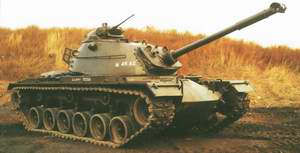 |
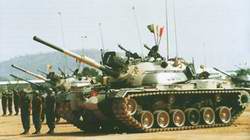 |
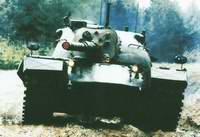 |
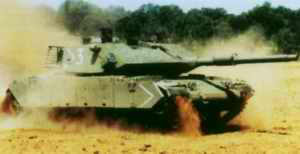 |
 |
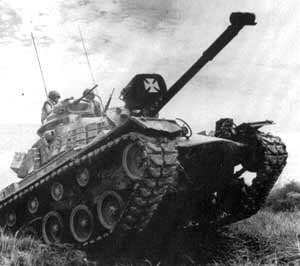 |
 |
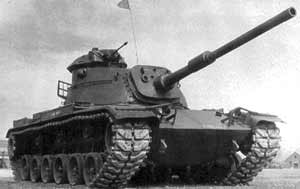 |
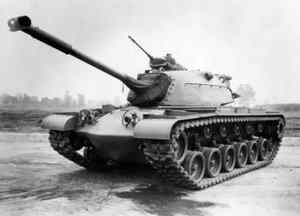 |














